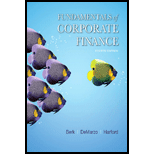
To determine: The way through which long term financial planning support the goal of the financial manager.
Introduction: Financial planning is an ongoing process of devising the course of action that will help in achieving the future goal smoothly.
Answer to Problem 1CC
Solution: The long-term objective of
Explanation of Solution
The goal of the financial manger is to increase the stake of the shareholders in the company. The long term financial planning helps in achieving long term goals of the organization and helps in maintaining and increasing the profits of the company. As the profit increases the stake of the shareholders in the company also increases.
- For example, if a company is Planning to open a new plant so as to increase its production, then it is the job of the financial manager to think and analyze beforehand about whether this project is going to be financially possible or not.
His job is to determine whether they have adequate amount of funds available to finance that new plant or not and if not then what are the sources from where he is going to get the money, he has to evaluate the affect of this new plant on the image of the company. The role of the financial manger is to think beforehand about all this so that when they implement their decisions, they don’t have any problem opening the new factory.
This is long term financial planning, in which financial manager thinks beforehand about the future of the firm in financial terms, so when the time comes they can pass that time smoothly and by earning profit and not by losing it.
Hence, when due to long term financial planning, rise in profit takes place it increase the stake of the shareholders and helps in fulfilling goal of the financial manager.
Want to see more full solutions like this?
Chapter 18 Solutions
Fundamentals of Corporate Finance (4th Edition) (Berk, DeMarzo & Harford, The Corporate Finance Series)
- Which of the following is considered a capital market instrument? A) Treasury BillsB) Corporate BondsC) Savings AccountsD) Commercial Paperarrow_forwardNeed help! What does "beta" measure in finance? A) Market volatilityB) Company sizeC) Asset liquidityD) Risk relative to the marketarrow_forwardWhat does "beta" measure in finance? A) Market volatilityB) Company sizeC) Asset liquidityD) Risk relative to the marketarrow_forward
- Need answer without use of ai. What is a bond's "coupon rate"? A) Its market priceB) Its face valueC) Its annual interest payment as a percentage of face valueD) Its yield to maturityarrow_forwardWhat is an IPO? A) Internal Portfolio OptionB) Initial Public OfferingC) Investment Portfolio ObjectiveD) Indexed Price Opportunityarrow_forwardI need help! What is a bond's "coupon rate"? A) Its market priceB) Its face valueC) Its annual interest payment as a percentage of face valueD) Its yield to maturityarrow_forward
- What is a bond's "coupon rate"? A) Its market priceB) Its face valueC) Its annual interest payment as a percentage of face valueD) Its yield to maturityarrow_forwardNo chatgpt!! What is the "time value of money"? A) Money today is worth more than the same amount in the futureB) Money loses value over time due to inflationC) Future value is higher than present valueD) Interest rates remain constant over timearrow_forwardI need help! What is the "time value of money"? A) Money today is worth more than the same amount in the futureB) Money loses value over time due to inflationC) Future value is higher than present valueD) Interest rates remain constant over timearrow_forward
- What is the "time value of money"? A) Money today is worth more than the same amount in the futureB) Money loses value over time due to inflationC) Future value is higher than present valueD) Interest rates remain constant over timearrow_forwardNo AI What is the primary function of a stock exchange? A) To regulate company operationsB) To facilitate the buying and selling of securitiesC) To issue government bondsD) To monitor inflation ratesarrow_forwardWhat does "diversification" aim to achieve in investment? A) Increase returnsB) Minimize transaction costsC) Reduce riskD) Avoid taxes no aiarrow_forward
 Essentials Of InvestmentsFinanceISBN:9781260013924Author:Bodie, Zvi, Kane, Alex, MARCUS, Alan J.Publisher:Mcgraw-hill Education,
Essentials Of InvestmentsFinanceISBN:9781260013924Author:Bodie, Zvi, Kane, Alex, MARCUS, Alan J.Publisher:Mcgraw-hill Education,

 Foundations Of FinanceFinanceISBN:9780134897264Author:KEOWN, Arthur J., Martin, John D., PETTY, J. WilliamPublisher:Pearson,
Foundations Of FinanceFinanceISBN:9780134897264Author:KEOWN, Arthur J., Martin, John D., PETTY, J. WilliamPublisher:Pearson, Fundamentals of Financial Management (MindTap Cou...FinanceISBN:9781337395250Author:Eugene F. Brigham, Joel F. HoustonPublisher:Cengage Learning
Fundamentals of Financial Management (MindTap Cou...FinanceISBN:9781337395250Author:Eugene F. Brigham, Joel F. HoustonPublisher:Cengage Learning Corporate Finance (The Mcgraw-hill/Irwin Series i...FinanceISBN:9780077861759Author:Stephen A. Ross Franco Modigliani Professor of Financial Economics Professor, Randolph W Westerfield Robert R. Dockson Deans Chair in Bus. Admin., Jeffrey Jaffe, Bradford D Jordan ProfessorPublisher:McGraw-Hill Education
Corporate Finance (The Mcgraw-hill/Irwin Series i...FinanceISBN:9780077861759Author:Stephen A. Ross Franco Modigliani Professor of Financial Economics Professor, Randolph W Westerfield Robert R. Dockson Deans Chair in Bus. Admin., Jeffrey Jaffe, Bradford D Jordan ProfessorPublisher:McGraw-Hill Education





